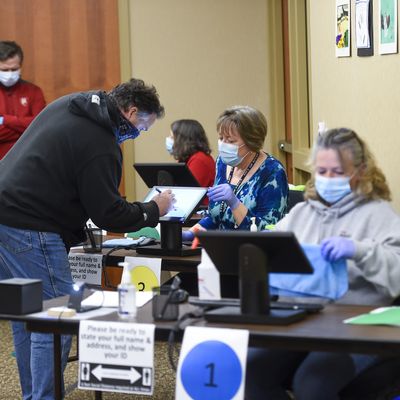
My initial reaction to the upset win by Jill Karofsky in Wisconsin’s officially nonpartisan but intensely ideological State Supreme Court election was all about karma: Republicans went to epic lengths to hold down turnout in order to reelect conservative judge Daniel Kelly, and lost anyway.
Indeed, they lost badly, as the final returns indicated, with Karofsky winning by ten points, achieving the standard definition of a landslide in a state where virtually every recent election has been close. Given Wisconsin’s key role in electing Donald Trump in 2016, and its potential status as a tipping-point state this year, the judicial results may have more national significance than one might immediately discern. Charlie Sykes, a veteran Wisconsin political observer and editor-in-chief of the Bulwark, certainly thinks so:
[T]he scope and nature of Kelly’s defeat was historically humiliating.
No incumbent supreme court justice had been defeated since 2008, when a conservative challenger ousted liberal justice Louis Butler. That victory turned out to be part of a remarkable run for conservatives who would go on to build a 5-2 majority on the court. (It will now be 4-3.)
And until Monday night, no incumbent conservative justice appointed by a Republican governor had been defeated. (Kelly had been appointed by former Governor Scott Walker.)
This was, of course, the epitome of an atypical election. But it’s hard not to look at the results and see a pattern that should worry Republicans everywhere, as Reid Epstein suggests:
Wisconsin’s map on Monday night looked like a dream general election result for former Vice President Joseph R. Biden Jr., the presumptive Democratic nominee — stronger than typical for Democrats in the suburbs and a respectable showing among the state’s blue-collar white voters in rural counties …
The decisive Democratic win offered a signal that the party, highly energized and mobilized heading into 2020, could organize and execute a winning get-out-the-vote program against strident Republican efforts to limit voter turnout in a narrowly divided state widely expected to be crucial in this fall’s presidential election.
Keep in mind that this is the rare general-election test we’ve seen this year: It’s not just a poll, or a primary in which the two parties compare their turnout, but an actual red-versus-blue face-off in which both parties invested mightily, even as the red team tilted the board with its drive to reduce voting-by-mail opportunities. Thus, it makes sense to make Wisconsin a fresh data point in a pattern that goes back to the first day of the Trump administration, as Sykes writes:
[A]t some point Republicans are going to have to look at exactly what has been happening across the country over the last three years:
* A Democrat wins a Senate race in Alabama
* A Democrat becomes governor in Kentucky
* A Democrat recaptures the governorship of New Jersey
* Democrats take control of the House of Representatives
* Democrats win unified control of the state government in Virginia
* Liberal Jill Karofsky blows out an incumbent conservative Wisconsin Supreme Court judge
Making any prediction of how a deeply polarized nation in the midst of a deadly pandemic and on the brink of an economic depression is going to vote in November is folly. But the endlessly expressed confidence we heard from Republicans earlier this year that Trump’s reelection was so certain — such a totally done deal — that Democrats impeached him in a panic isn’t looking very sensible at this point. Anything could happen, but it might be time for the president’s partisans to stop with the anticipatory gloating and get to work, and not just by trying to keep people from voting.






























